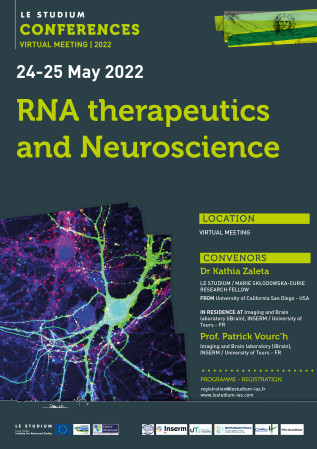Dr Kathia Zaleta

From
University of California San Diego - USA
In residence at
Imaging and Brain laboratory (iBrain) / INSERM, University of Tours - FR
Host scientist
Prof. Patrick Vourch'
Project
Protein translation enhancement therapy for the treatment of neurodegenerative diseases
Neurodegenerative diseases are characterized by degeneration of neurons in the brain affecting millions of people worldwide. Synaptic dysfunction has been noted as one of the earliest hallmarks, occurring in advance of neuronal death in Alzheimer disease (AD), which is the most common type of neurodegenerative diseases, and in second place Amyotrophic lateral sclerosis (ALS). Both AD and ALS show similar synapse pathology due to a decrease of the synaptic vesicles proteins (i.e.
synaptophysin and synapsin 1) affecting synapses, which is essential for transmitting, processing and storing information. Currently there is not cure for both neurodegenerative disorders, current treatments remains palliative and no therapy exists which approaches the root cause of the condition. Reduction of synaptic transmission in AD and ALS is caused by progressive down regulation of many synaptic genes affecting synapses, thus I propose that introduction of specific RNA enhancement (RNAe) constructs targeting down regulated mRNA transcripts of synaptic genes to enhance protein translation and synapses as a consequence may help to revert the disease phenotype. My long-term goal is to use RNAe to develop a gene therapy for patients with neurodegenerative disorders, specifically AD and ALS. My central hypothesis is that stabilization of synaptic genes’ mRNAs by RNAe will be effective in enhancing the levels of the targeted proteins that are down-regulated. To investigate, we will pursue the following specific aims: In Aim 1, we will carry out in vitro studies in cell line’s models to select specific RNAe constructs that will lead to translation enhancement and normalize the protein levels of down regulated synaptic genes (synaptophysin and synapsin 1). In Aim 2, we will utilize selected RNAe constructs from Aim 1 to carry out preclinical in vivo studies in transgenic mouse models. Transgenic mice will be treated at the early stages of AD and ALS during several months. We will follow behavioral performances every weeks, and at the end of the treatment we will assess disease phenotype and disease biomarkers. We will also address a possible toxic effect caused by the therapeutic RNAe constructs. The outcome of this work will lead to development of a therapy to prevent and treat neurodegenerative diseases such as AD and ALS.
Publications
Final reports
Synaptic transmission is of critical importance for the neurons to communicate, and abnormalities are observed in neurodegenerative diseases, psychiatric disorders, and intellectual disability. Loss of the synaptic vesicle proteins is shared among these disorders and is being noted as one of the earliest hallmarks of neurogenerative diseases. Therefore, novel therapeutics targeting synapses are fundamental to improve brain plasticity and maintain a healthy brain function. Here, we propose to normalize synaptic protein levels by targeting unstable synaptic mRNAs using antisense RNA enhancer molecules with the ‘long-term goal’ of developing a therapy for patients with synaptic dysfunction, specifically in Alzheimer’s Disease (AD) and Amyotrophic Lateral Sclerosis (ALS). Our ‘hypothesis’ is that stabilization of unstable synaptic mRNA’s by antisense RNA molecules will be effective in enhancing and restore the levels of downregulated synaptic proteins in AD and ALS. As a ‘proof of concept’ antisense RNA molecules targeting 5’UTR regions of unstable synaptic genes (synapsin and synaptophysin) fused to enhancer elements such as SINE. To explore the efficacy and specificity, three different binding domains that span the 5’UTR region and transcription start sites (-40/+32, -40/+4, -14/+4) per gene were prepared and screened in a cell line that endogenously expresses the target genes. Our preliminary results show that SINEUP elements enhanced protein translation of the synapsin dimer by 80% and the monomers by 40%. This significant enhancement can stimulate synaptogenesis, synaptic vesicle recruitment, and maintain the mature synapses. An increase in synaptophysin was also observed. Ex vivo studies using a diseased cell model are in progress to assess phenotype and function. This is a promising step toward targeting synapses in neurodegenerative diseases.


